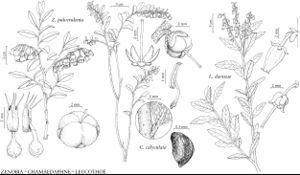Difference between revisions of "Zenobia"
Edinburgh New Philos. J. 17: 158. 1834 ,.
FNA>Volume Importer |
FNA>Volume Importer |
||
| Line 48: | Line 48: | ||
|publication year= | |publication year= | ||
|special status= | |special status= | ||
| − | |source xml=https://jpend@bitbucket.org/aafc-mbb/fna-data-curation.git/src/ | + | |source xml=https://jpend@bitbucket.org/aafc-mbb/fna-data-curation.git/src/f50eec43f223ca0e34566be0b046453a0960e173/coarse_grained_fna_xml/V8/V8_988.xml |
|subfamily=Ericaceae subfam. Vaccinioideae | |subfamily=Ericaceae subfam. Vaccinioideae | ||
|genus=Zenobia | |genus=Zenobia | ||
Revision as of 22:33, 16 December 2019
Shrubs, (glabrous, often glaucous). Stems erect, twigs glabrous. Leaves deciduous to semipersistent; blade elliptic to elliptic-ovate or ovate, coriaceous, margins irregularly and shallowly serrulate-crenulate or entire, plane, surfaces finely hairy, glabrescent; venation reticulodromous or brochidodromous. Inflorescences axillary racemes of (2–)5–12-flowered corymbs, or solitary flowers, borne on leafless stems. Flowers: sepals 5, distinct, ovate to ovate-deltate; petals 5, connate ca. 3/4 their lengths, white, corolla broadly campanulate, lobes much shorter than tube; stamens 10, included; filaments straight, flattened, dilated proximally, glabrous, without spurs; anthers with 4 awns, dehiscent by oblong pores, (disintegration tissue present in connective); pistil 5-carpellate; ovary 5-locular; stigma truncate. Fruits capsular, 5-valved, depressed-globose, dry. Seeds 40–200, ovoid; testa smooth. x = 11.
Distribution
se United States.
Discussion
Species 1: se United States.
Species 1
